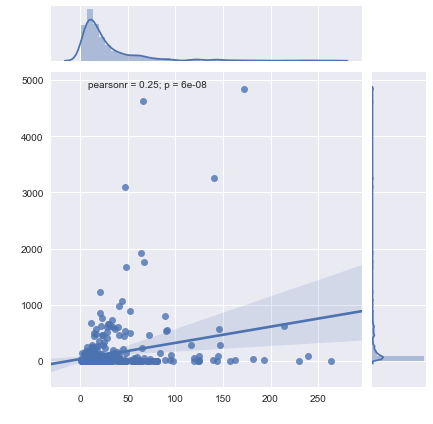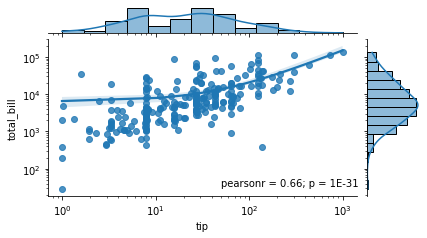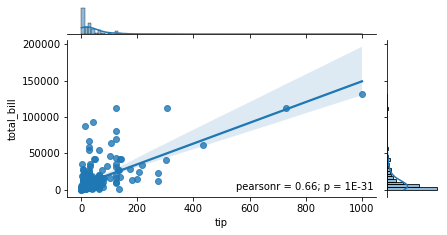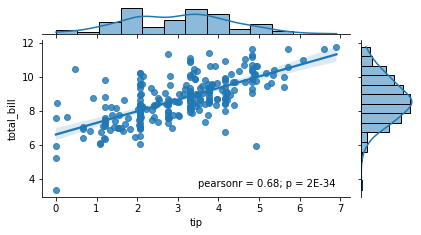To log-scale the plots, another way is to pass log_scale argument to the marginal component of jointplot1, which can be done via marginal_kws= argument.
import seaborn as sns
from scipy import stats
data = sns.load_dataset('tips')[['tip', 'total_bill']]**3
graph = sns.jointplot(x='tip', y='total_bill', data=data, kind='reg', marginal_kws={'log_scale': True})
# ^^^^^^^^^^^^^ here
pearsonr, p = stats.pearsonr(data['tip'], data['total_bill'])
graph.ax_joint.annotate(f'pearsonr = {pearsonr:.2f}; p = {p:.0E}', xy=(35, 50));
![result1a]()
if we don't log-scale the axes, we get the following plot:2
![result1b]()
Note that the correlation coefficients are the same because the underlying regression functions used to derive the two lines of fit are the same.
Even though the line of fit doesn't look linear in the first plot above, it is indeed linear, it's just the axes are log-scaled which "warps" the view. Under the covers, sns.jointplot() calls sns.regplot() to plot the scatter plot and the line of fit, so if we call it using the same data and log-scale the axes, we will get the same plot. In other words, the following will produce the same scatter plot.
sns.regplot(x='tip', y='total_bill', data=data).set(xscale='log', yscale='log');
If you take log of the data before passing it to jointplot(), that would be a different model altogether (and you probably don't want it), because now the regression coefficients will come from log(y)=a+b*log(x), not y=a+b*x as before.
You can see the difference in the plot below. Even though the line of fit now looks linear, the correlation coefficient is different now.
![result2]()
1 The marginal plots are plotted using sns.histplot, which admits the log_scale argument.
2 A convenience function to plot the graphs in this post:
from scipy import stats
def plot_jointplot(x, y, data, xy=(0.4, 0.1), marginal_kws=None, figsize=(6,4)):
# compute pearsonr
pearsonr, p = stats.pearsonr(data[x], data[y])
# plot joint plot
graph = sns.jointplot(x=x, y=y, data=data, kind='reg', marginal_kws=marginal_kws)
# annotate the pearson r results
graph.ax_joint.annotate(f'pearsonr = {pearsonr:.2f}; p = {p:.0E}', xy=xy);
# set figsize
graph.figure.set_size_inches(figsize);
return graph
data = sns.load_dataset('tips')[['tip', 'total_bill']]**3
plot_jointplot('tip', 'total_bill', data, (50, 35), {'log_scale': True}) # log-scaled
plot_jointplot('tip', 'total_bill', data, (550, 3.5)) # linear-scaled
plot_jointplot('tip', 'total_bill', np.log(data), (3.5, 3.5)) # linear-scaled on log data





